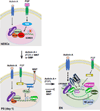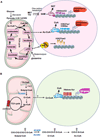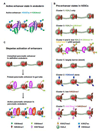Metabolic and epigenetic regulation of endoderm differentiation
- PMID: 34607773
- PMCID: PMC8760149
- DOI: 10.1016/j.tcb.2021.09.002
Metabolic and epigenetic regulation of endoderm differentiation
Abstract
The endoderm, one of the three primary germ layers, gives rise to lung, liver, stomach, intestine, colon, pancreas, bladder, and thyroid. These endoderm-originated organs are subject to many life-threatening diseases. However, primary cells/tissues from endodermal organs are often difficult to grow in vitro. Human pluripotent stem cells (hPSCs), therefore, hold great promise for generating endodermal cells and their derivatives for the development of new therapeutics against these human diseases. Although a wealth of research has provided crucial information on the mechanisms underlying endoderm differentiation from hPSCs, increasing evidence has shown that metabolism, in connection with epigenetics, actively regulates endoderm differentiation in addition to the conventional endoderm inducing signals. Here we review recent advances in metabolic and epigenetic regulation of endoderm differentiation.
Keywords: endoderm differentiation; endodermal gene expression; epigenetic remodeling; histone crotonylation; metabolic switch.
Published by Elsevier Ltd.
Conflict of interest statement
Declaration of interests The authors declare no competing interests.
Figures




Similar articles
-
Human Pluripotent Stem Cell-Derived Endoderm for Modeling Development and Clinical Applications.Cell Stem Cell. 2018 Apr 5;22(4):485-499. doi: 10.1016/j.stem.2018.03.016. Cell Stem Cell. 2018. PMID: 29625066 Review.
-
Generation of endoderm lineages from pluripotent stem cells.Regen Med. 2017 Jan;12(1):77-89. doi: 10.2217/rme-2016-0086. Epub 2016 Dec 15. Regen Med. 2017. PMID: 27976977 Review.
-
Development of a rapid screen for the endodermal differentiation potential of human pluripotent stem cell lines.Sci Rep. 2016 Nov 22;6:37178. doi: 10.1038/srep37178. Sci Rep. 2016. PMID: 27872482 Free PMC article.
-
Generation of vascularized pancreatic progenitors through co-differentiation of endoderm and mesoderm from human pluripotent stem cells.Stem Cell Res Ther. 2024 Dec 24;15(1):502. doi: 10.1186/s13287-024-04120-5. Stem Cell Res Ther. 2024. PMID: 39719603 Free PMC article.
-
Differentiation of human pluripotent stem cells toward pharyngeal endoderm derivatives: Current status and potential.Curr Top Dev Biol. 2020;138:175-208. doi: 10.1016/bs.ctdb.2020.01.004. Epub 2020 Feb 25. Curr Top Dev Biol. 2020. PMID: 32220297 Review.
Cited by
-
CHD7 regulates definitive endodermal and mesodermal development from human embryonic stem cells.Stem Cell Res Ther. 2025 Jun 17;16(1):311. doi: 10.1186/s13287-025-04437-9. Stem Cell Res Ther. 2025. PMID: 40528267 Free PMC article.
-
Overcoming the Limitations of Stem Cell-Derived Beta Cells.Biomolecules. 2022 Jun 9;12(6):810. doi: 10.3390/biom12060810. Biomolecules. 2022. PMID: 35740935 Free PMC article. Review.
-
Down-regulation of Lon protease 1 lysine crotonylation aggravates mitochondrial dysfunction in polycystic ovary syndrome.MedComm (2020). 2023 Oct 9;4(5):e396. doi: 10.1002/mco2.396. eCollection 2023 Oct. MedComm (2020). 2023. PMID: 37817894 Free PMC article.
-
The Role of Long Non-Coding RNAs in Human Endoderm Differentiation.Noncoding RNA. 2025 Apr 13;11(2):29. doi: 10.3390/ncrna11020029. Noncoding RNA. 2025. PMID: 40278506 Free PMC article. Review.
-
Long noncoding RNA as an emerging regulator of endoderm differentiation: progress and perspectives.Cell Regen. 2025 Mar 26;14(1):11. doi: 10.1186/s13619-025-00230-4. Cell Regen. 2025. PMID: 40133743 Free PMC article. Review.
References
-
- Yiangou L et al. (2018) Human Pluripotent Stem Cell-Derived Endoderm for Modeling Development and Clinical Applications. Cell Stem Cell 22 (4), 485–499. - PubMed
-
- Tam PP and Beddington RS (1987) The formation of mesodermal tissues in the mouse embryo during gastrulation and early organogenesis. Development 99 (1), 109–26. - PubMed
-
- Lawson KA et al. (1991) Clonal analysis of epiblast fate during germ layer formation in the mouse embryo. Development 113 (3), 891–911. - PubMed
-
- Tada S et al. (2005) Characterization of mesendoderm: a diverging point of the definitive endoderm and mesoderm in embryonic stem cell differentiation culture. Development 132 (19), 4363–74. - PubMed
Publication types
MeSH terms
Grants and funding
LinkOut - more resources
Full Text Sources

